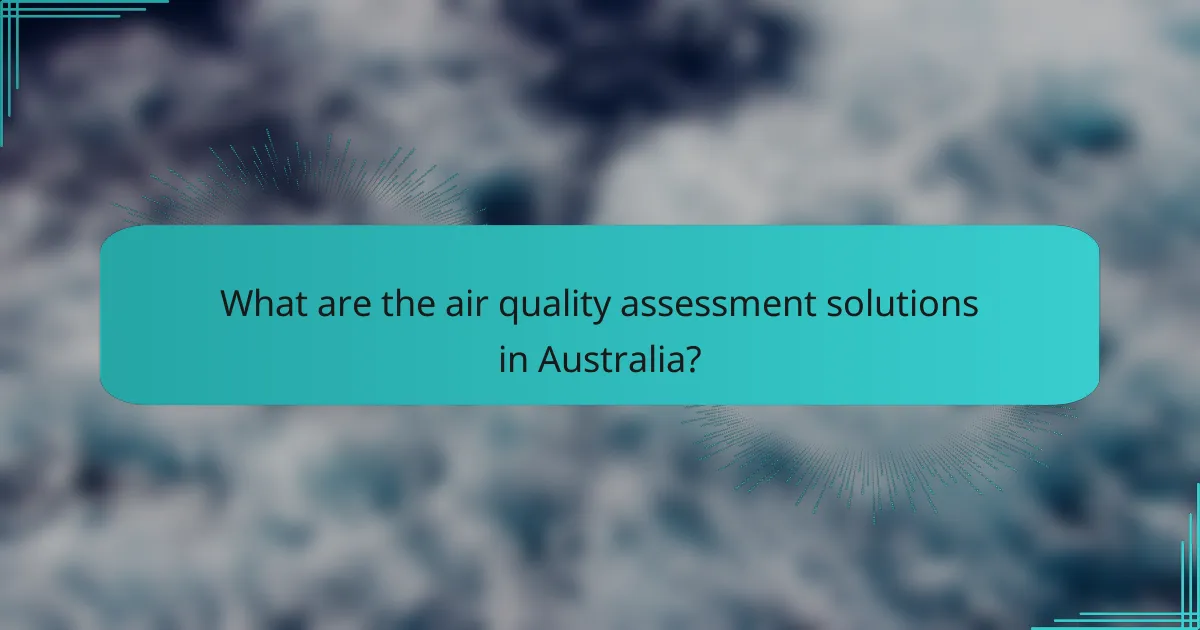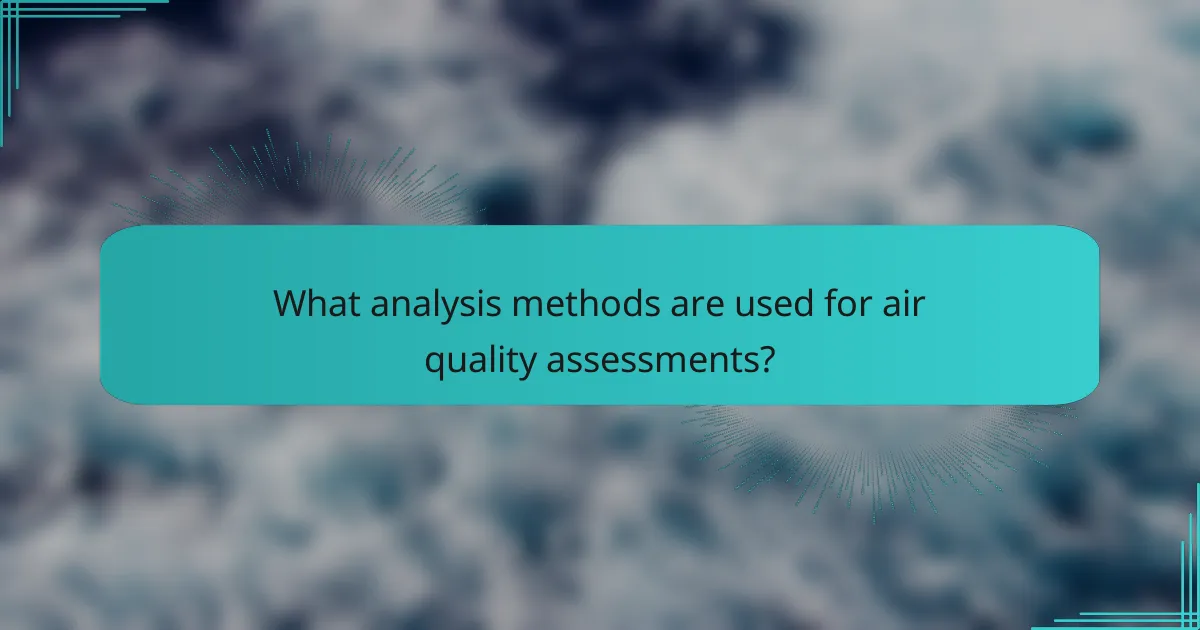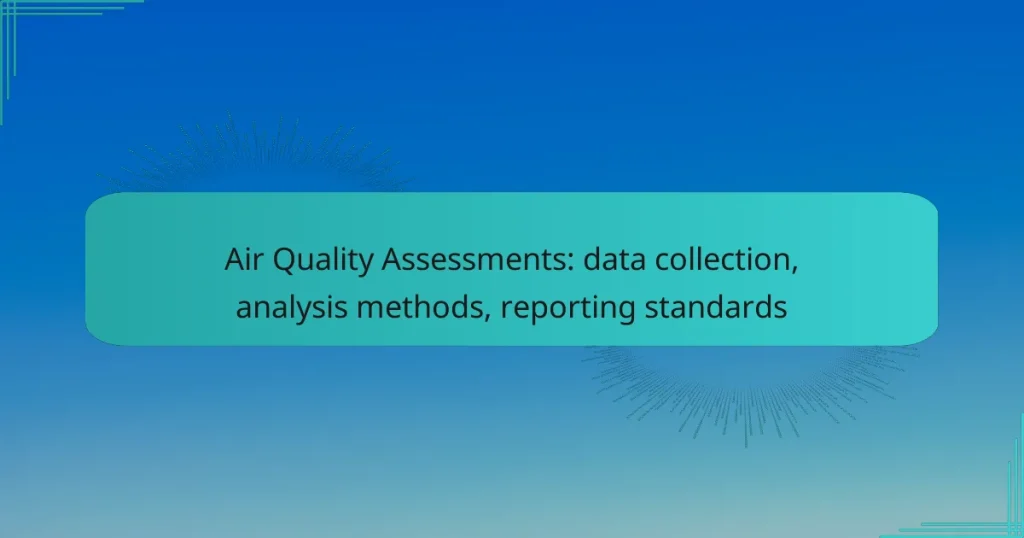Air quality assessments are essential for understanding and managing pollution levels, employing a range of technologies and methods for data collection and analysis. These assessments utilize fixed monitoring stations, portable devices, and satellite observations to gather comprehensive data, while advanced analytical techniques, including statistical and machine learning methods, help interpret the findings. Adhering to established reporting standards ensures that the information is accessible and actionable for both the public and regulatory bodies.

What are the air quality assessment solutions in Australia?
Air quality assessment solutions in Australia encompass various technologies and methods designed to monitor and analyze air pollution levels. These solutions include real-time monitoring systems, mobile apps, indoor sensors, remote sensing technologies, and community initiatives that collectively enhance public awareness and regulatory compliance.
Real-time monitoring systems
Real-time monitoring systems are fixed installations that continuously measure air quality parameters such as particulate matter, nitrogen dioxide, and ozone levels. These systems provide immediate data, allowing for timely responses to pollution events and compliance with environmental regulations.
In Australia, these systems are often operated by government agencies and can be found in urban areas where air quality is a concern. They typically use advanced sensors and data transmission technologies to relay information to central databases for analysis and public access.
Mobile air quality apps
Mobile air quality apps provide users with real-time air quality information directly on their smartphones. These applications aggregate data from various monitoring stations and sensors, offering localized air quality indices and forecasts.
Popular apps in Australia include AirVisual and Breezometer, which allow users to track pollution levels and receive alerts. Users should consider the app’s data sources and update frequency to ensure accurate information.
Indoor air quality sensors
Indoor air quality sensors measure pollutants within enclosed spaces, such as homes and offices. These devices can detect volatile organic compounds (VOCs), carbon dioxide, and humidity levels, helping to maintain a healthy indoor environment.
In Australia, many households are adopting these sensors to monitor air quality and improve ventilation. When selecting a sensor, consider features like calibration, data logging, and connectivity to mobile apps for better usability.
Remote sensing technologies
Remote sensing technologies utilize satellite and aerial imagery to assess air quality over large areas. These methods can track pollution sources and dispersion patterns, providing valuable insights for environmental management.
In Australia, remote sensing is particularly useful for monitoring bushfire smoke and its impact on air quality across vast regions. This technology complements ground-based measurements and helps inform public health advisories during pollution events.
Community-based monitoring initiatives
Community-based monitoring initiatives empower local residents to participate in air quality assessments using low-cost sensors. These grassroots efforts can enhance data collection in areas lacking formal monitoring stations.
In Australia, programs like the Citizen Science Air Quality Project encourage community involvement and raise awareness about air pollution. Participants should ensure that the sensors used are reliable and that data is shared transparently for maximum impact.

How is air quality data collected?
Air quality data is collected using various methods that provide insights into pollutant levels and atmospheric conditions. These methods include fixed monitoring stations, portable sampling devices, satellite observations, and crowdsourced data collection, each with unique advantages and considerations.
Fixed monitoring stations
Fixed monitoring stations are permanent installations that continuously measure air quality parameters such as particulate matter, nitrogen dioxide, and ozone. These stations are strategically placed in urban and industrial areas to provide reliable data over time.
Typically, they adhere to national and international standards, ensuring data accuracy and comparability. However, their fixed locations may not capture variations in air quality across different regions or during specific events.
Portable sampling devices
Portable sampling devices are versatile tools that allow for air quality measurements in various locations. These devices can be used for short-term studies or to assess specific areas where fixed stations may not exist.
While they offer flexibility and can provide detailed data, the accuracy may vary based on calibration and environmental conditions. Users should ensure proper handling and maintenance to avoid data discrepancies.
Satellite observations
Satellite observations utilize remote sensing technology to monitor air quality on a global scale. Satellites can track large-scale atmospheric phenomena and provide data on pollutants like carbon monoxide and aerosols.
This method is particularly useful for assessing air quality in remote or inaccessible areas, though it may lack the granularity of ground-based measurements. Combining satellite data with other methods can enhance overall understanding of air quality trends.
Crowdsourced data collection
Crowdsourced data collection involves gathering air quality information from individuals using mobile apps or personal monitoring devices. This approach leverages community participation to create a more comprehensive air quality map.
While crowdsourced data can fill gaps in traditional monitoring, its reliability can vary based on user expertise and device calibration. Establishing guidelines for data submission can improve the overall quality of the collected information.

What analysis methods are used for air quality assessments?
Air quality assessments utilize various analysis methods to evaluate pollutant levels and their impacts on health and the environment. Common techniques include statistical analysis, machine learning models, geospatial analysis, and comparative studies, each offering unique insights and advantages.
Statistical analysis techniques
Statistical analysis techniques are fundamental in air quality assessments, providing a way to interpret data collected from monitoring stations. Methods such as regression analysis, time series analysis, and hypothesis testing help identify trends and correlations between air quality indicators and potential health outcomes.
For instance, regression analysis can quantify the relationship between pollutant concentrations and respiratory diseases, while time series analysis can reveal seasonal patterns in air quality. It’s essential to ensure that the data is representative and that appropriate statistical tests are chosen to avoid misleading conclusions.
Machine learning models
Machine learning models are increasingly used in air quality assessments to predict pollution levels and identify sources of emissions. These models can analyze large datasets, including meteorological data and historical pollution records, to improve accuracy in forecasting air quality.
Common algorithms include decision trees, support vector machines, and neural networks. When implementing machine learning, it’s crucial to have a well-defined training dataset and to validate the model against real-world observations to ensure reliability.
Geospatial analysis
Geospatial analysis leverages geographic information systems (GIS) to visualize and analyze air quality data in relation to location. This method helps identify pollution hotspots and assess the spatial distribution of air quality issues across urban and rural areas.
By overlaying air quality data with demographic and land-use information, analysts can better understand how environmental factors affect different populations. Utilizing tools like heat maps can effectively communicate findings to stakeholders and inform policy decisions.
Comparative studies
Comparative studies involve analyzing air quality data across different regions or time periods to evaluate the effectiveness of policies or interventions. This method can highlight the impact of regulatory changes or technological advancements on air quality improvements.
For example, comparing air quality before and after the implementation of stricter emissions standards can provide insights into the effectiveness of those regulations. It’s important to control for confounding variables to ensure that observed changes are attributable to the interventions being studied.

What are the reporting standards for air quality assessments?
Reporting standards for air quality assessments provide guidelines on how to collect, analyze, and report air quality data. These standards ensure consistency, accuracy, and transparency in air quality monitoring and reporting across different regions and organizations.
National Environment Protection Measures (NEPM)
The National Environment Protection Measures (NEPM) are a set of guidelines established in Australia to ensure uniform air quality standards across the country. NEPM outlines specific air pollutants to monitor, such as particulate matter, ozone, and nitrogen dioxide, and sets permissible levels for these substances.
Compliance with NEPM is essential for local governments and industries, as it helps to protect public health and the environment. Regular assessments and reports are required to demonstrate adherence to these standards, often involving collaboration with state and territory governments.
ISO 16000 standards
ISO 16000 standards are international guidelines that focus on indoor air quality assessment. These standards cover various aspects, including sampling methods, measurement techniques, and data analysis for pollutants like volatile organic compounds (VOCs) and formaldehyde.
Organizations conducting indoor air quality assessments should adhere to ISO 16000 to ensure reliable results. This can involve using specific equipment and following prescribed methodologies to maintain consistency and accuracy in reporting.
World Health Organization guidelines
The World Health Organization (WHO) provides guidelines that set recommended air quality levels to protect public health globally. These guidelines include threshold values for key pollutants, such as particulate matter and carbon monoxide, which are critical for assessing air quality.
Countries often use WHO guidelines as a benchmark for developing their air quality standards. Adopting these guidelines can help local authorities implement effective air quality management strategies and improve public health outcomes.
Local government reporting frameworks
Local government reporting frameworks vary by region but generally include specific requirements for air quality data collection and reporting. These frameworks often align with national standards but may include additional local pollutants or stricter limits based on regional health concerns.
Local authorities are responsible for monitoring air quality and reporting findings to the public. Effective frameworks facilitate transparency and community engagement, ensuring that residents are informed about air quality issues and potential health risks.

What are the key criteria for selecting air quality assessment methods?
When selecting air quality assessment methods, key criteria include accuracy, reliability, cost, and the specific pollutants of interest. These factors help ensure that the data collected is valid and useful for regulatory compliance and public health protection.
Accuracy and reliability
Accuracy refers to how closely the measured values reflect the true concentrations of pollutants, while reliability indicates the consistency of these measurements over time. Methods such as reference-grade monitors provide high accuracy but may be costly and require regular calibration.
To ensure reliable results, consider using multiple assessment methods or cross-referencing data with established standards. For instance, low-cost sensors can be useful for preliminary assessments, but they should be validated against more accurate instruments to confirm their reliability.

